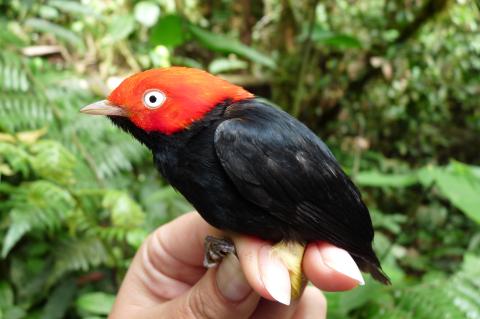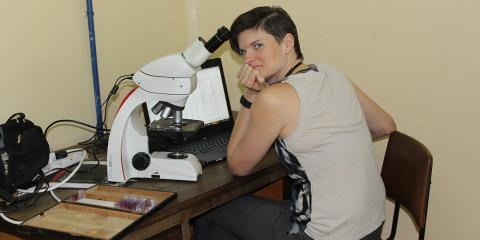News Archive
Filter By
- Abyssinian ground hornbill
- Addax
- Aldabra tortoise
- Allen's swamp monkey
- Alpaca
- American alligator
- American avocet
- American bison
- American flamingo
- American wigeon
- Andean bear
- Aquatic caecilian
- Arapaima
- Asian elephant
- Asian small-clawed otter
- Asian water dragon
- Australian snake-necked turtle
- Bald eagle
- Baltimore oriole
- Barred owl
- Bearded emperor tamarin
- Beaver
- Bennett's wallaby
- Binturong
- Black-and-white ruffed lemur
- Black-crowned night heron
- Black-footed ferret
- Black-tailed prairie dog
- Black-throated blue warbler
- Blue-billed curassow
- Blue crane
- Bobcat
- Brown pelican
- Bufflehead
- California sea lion
- Canvasback
- Cedar waxwing
- Channel catfish
- Cheetah
- Chicken
- Chinese alligator
- Chinese three-striped box turtle
- Clouded leopard
- Collared brown lemur
- Common raven
- Common yellowthroat
- Corals and sea anemones (anthozoa)
- Cow
- Crocodile monitor
- Cuban crocodile
- Dama gazelle
- Degu
- Dunlin
- Eastern corn snake
- Eastern indigo snake
- Eastern newt
- Eastern red-backed salamander
- Eastern screech-owl
- Eld's deer
- Electric eel
- Emperor newt
- Fennec fox
- Fishing cat
- Gaboon viper
- Geoffroy's marmoset
- Gharial
- Giant leaf-tailed gecko
- Giant panda
- Goat
- Golden-headed lion tamarin
- Golden lion tamarin
- Gray seal
- Gray wolf
- Green tree python
- Grevy's zebra
- Guam kingfisher (sihek)
- Guam rail (ko’ko’)
- Guinea pig
- Harbor seal
- Hartmann's mountain zebra
- Hawk-headed parrot
- Hellbender
- Home's hinge-back tortoise
- Hooded crane
- Iranian fat-tailed gecko
- Japanese giant salamander
- King vulture
- Komodo dragon
- Kori bustard
- Kunekune pig
- Land hermit crab
- Larger Malay mouse-deer
- Lemur leaf frog
- Lesser hedgehog tenrec
- Lesser kudu
- Lion
- Loggerhead shrike
- Long-tailed chinchilla
- Long-tailed salamander
- Maned wolf
- Meerkat
- Miniature donkey
- Naked mole-rat
- North American porcupine
- North American river otter
- Northern Luzon giant cloud rat
- Northern pine snake
- Northern pintail
- Northern red salamander
- Northern shoveler
- Northern snakehead fish
- Northern tree shrew
- North Island brown kiwi
- Norway rat
- Orangutan
- Orchard oriole
- Ossabaw Island hog
- Ostrich
- Ovenbird
- Pallas's cat
- Panamanian golden frog
- Patagonian mara
- Persian onager
- Philippine crocodile
- Prehensile-tailed porcupine
- Prevost's squirrel
- Przewalski's horse
- Pygmy slow loris
- Red-crowned crane
- Red-fronted lemur
- Red-rumped agouti
- Red-winged blackbird
- Red knot
- Red panda
- Red River hog
- Red ruffed lemur
- Red wolf
- Ring-tailed lemur
- Ruddy duck
- Schmidt's red-tailed monkey
- Scimitar-horned oryx
- Screaming hairy armadillo
- Semipalmated plover
- Semipalmated sandpiper
- Siamang
- Sitatunga
- Sloth bear
- Southern lesser galago
- Southern swamp sparrow
- Southern tamandua
- Spider tortoise
- Striped skunk
- Tanagers
- Tentacled snake
- Tiger
- Titi monkey
- Turkey
- Twig catfish
- Two-toed sloth
- Vietnamese mossy frog
- Virginia opossum
- Von der Decken's hornbill
- Western lowland gorilla
- White-cheeked gibbon
- White-faced saki
- White-naped crane
- White-nosed coati
- Whooping crane
Displaying 1326 - 1350 of 2368 articles.
Elderly Gray Seal Dies at the Smithsonian’s National Zoo
The Smithsonian's National Zoo’s senior female gray seal, Selkie, died today. At 43 years old, Selkie was the oldest gray seal living in human care. The lifespan of a wild gray seal is usually 25 or 30 years. Typically, female gray seals in human care can live close to 40 years; male seals live...
Vote to Name the Agouti Baby
The Smithsonian National Zoo's new agouti needs a name and we need your help! As mom is “Hazelnut,” dad is “Pistachio” and sibling #1 is “Coconut,” the new agouti will help complete the mixed “nut” exhibit at the Small Mammal House. Native to South America and similar in appearance to a Guinea pig...
Preparing for the Second Release of Scimitar-Horned Oryx to the Wild in Chad
I traveled to the United Arab Emirates in early October to work on the second release of Scimitar-horned Oryx with our collaborators from the Environment Agency—Abu Dhabi (EAD). Scimitar-horned oryx are a desert antelope native to Northern Africa. The first release was completed over the summer when...

What Sound Does a Forest Make?
SCBI's Center for Conservation and Sustainability is in Peru's Amarakaeri Communal Reserve recording how life is responding to an area of the forest designated for natural gas exploration. Researchers Tremaine Gregory and Jessica Deichmann give us the scoop on their findings in this Science Q&A.
Media Advisory: ZooLights, Powered by Pepco, Returns to Smithsonian’s National Zoo
ZooLights, powered by Pepco, at the Smithsonian’s National Zoo is wilder than ever and a perfect holiday event for families. Hosted by Friends of the National Zoo, the festival will run over 35 days and features thousands of environmentally friendly LED lights.
Male Andean Bear Cisco Dies at the Smithsonian's National Zoo
A 23-year-old male Andean bear named Cisco died at the Smithsonian’s National Zoo Oct. 24 during an emergency veterinary exam. In the past week, Cisco became less active and began breathing more heavily with an occasional cough. Those signs worsened over the weekend and his appetite declined, which...
Giant Panda Bao Bao Moving to China Next Year
Giant panda Bao Bao will depart the Smithsonian’s National Zoo for China in late winter, within the first few months of 2017.
Bao Bao's Departure FAQs
Read on for some of the most frequently asked questions about Bao Bao's departure.
Geriatric Sloth Bear Dies at the Smithsonian’s National Zoo
A 21-year-old female sloth bear named Hana was humanely euthanized at the Smithsonian’s National Zoo Monday, Oct. 17. In human care, sloth bears typically have a median life expectancy of early-to-mid 20s. Hana exhibited signs of lethargy and discomfort as well as a decline in appetite over the...
Vector Surveillance in Kenya's Camels
In Kenya, the Smithsonian Institution maintains a close collaboration with the Mpala Research Center and Ranch (MRC) located in Laikipia County.
Zoo Improvement Collaboration in India
Smithsonian's Global Health Program is a contributor to the partnership between the Smithsonian’s National Zoo and Conservation Biology Institute and India’s Central Zoo Authority. This collaboration aims to share best-practices in veterinary medicine and diagnostics with zoos in India, which are...

Virus Detection in Myanmar's Bats
Smithsonian's Global Health Program (SGHP), through the U.S. Agency for International Development (USAID) PREDICT program, aims to strengthen developing countries’ ability to detect, control and prevent infectious diseases.

Update on Kenyan Rhinos
When a mysterious disease emerged in Kenyan black and white rhinos, Dr. Kali Holder headed Kenya to examine samples and train technicians in sample processing, hoping to discover clues to the cause of the disease.
The Vets Visit Bei Bei
Our veterinary team visited the giant panda habitat last week for routine checkups on all of the pandas. Of special note in Bei Bei's check-up, the team successfully collected blood and gave him two vaccinations. He held still for the procedure because keepers treated him to honey water. Keepers...
A Beetle Invasion
If you want to understand why trees are dying, just ask Kristina Anderson-Teixeira. Anderson-Teixeira’s job is to study forests and their interactions with climate. As a research biologist at SCBI’s Conservation Ecology Center, one of her particular interests is patterns in tree mortality. The...
SCBI Scientists Crack the Crane Case
For many endangered species, their future is only as promising as their genes are diverse. Genetic diversity is key to a population that is self-sustaining and can more effectively fight off disease. When it comes to cranes, which mate for life and produce relatively poor semen samples, bolstering...
Good News for Great Apes
What’s a zoo to do when an orangutan has the sniffles? Treatment depends on whether the infection is viral or bacterial, says Priscilla Joyner, the Smithsonian Conservation Biology Institute’s (SCBI’s) veterinary medical officer. She has teamed up with colleagues at the University of Miami to...
Kiwi Fun Facts
Since 1968 the Smithsonian's National Zoo and Conservation Biology Institute's scientists, animal keepers and researchers have been working to save kiwi from extinction. There's more to this unique bird than meets the eye—check out the fun facts below! The lifespan of kiwi both in the wild and in...
Eld's Deer Fawn Born
The Smithsonian Conservation Biology Institute welcomed an Eld’s deer fawn Oct. 2 around 4:30 p.m. Both the fawn and her mom Sienna appear to be doing well and the fawn is nursing. This is Sienna’s second fawn and the first for the fawn’s dad, Duffy. Keepers will weigh her several times a week to...
Where Do Wild Przewalski's Horses Roam?
A conservationist’s work is never done. At least, it doesn’t stop when a species is returned to its native habitat. Instead, scientists at the Smithsonian Conservation Biology Institute’s (SCBI) Conservation Ecology Center use satellite tracking collars to understand the challenges animals face once...
